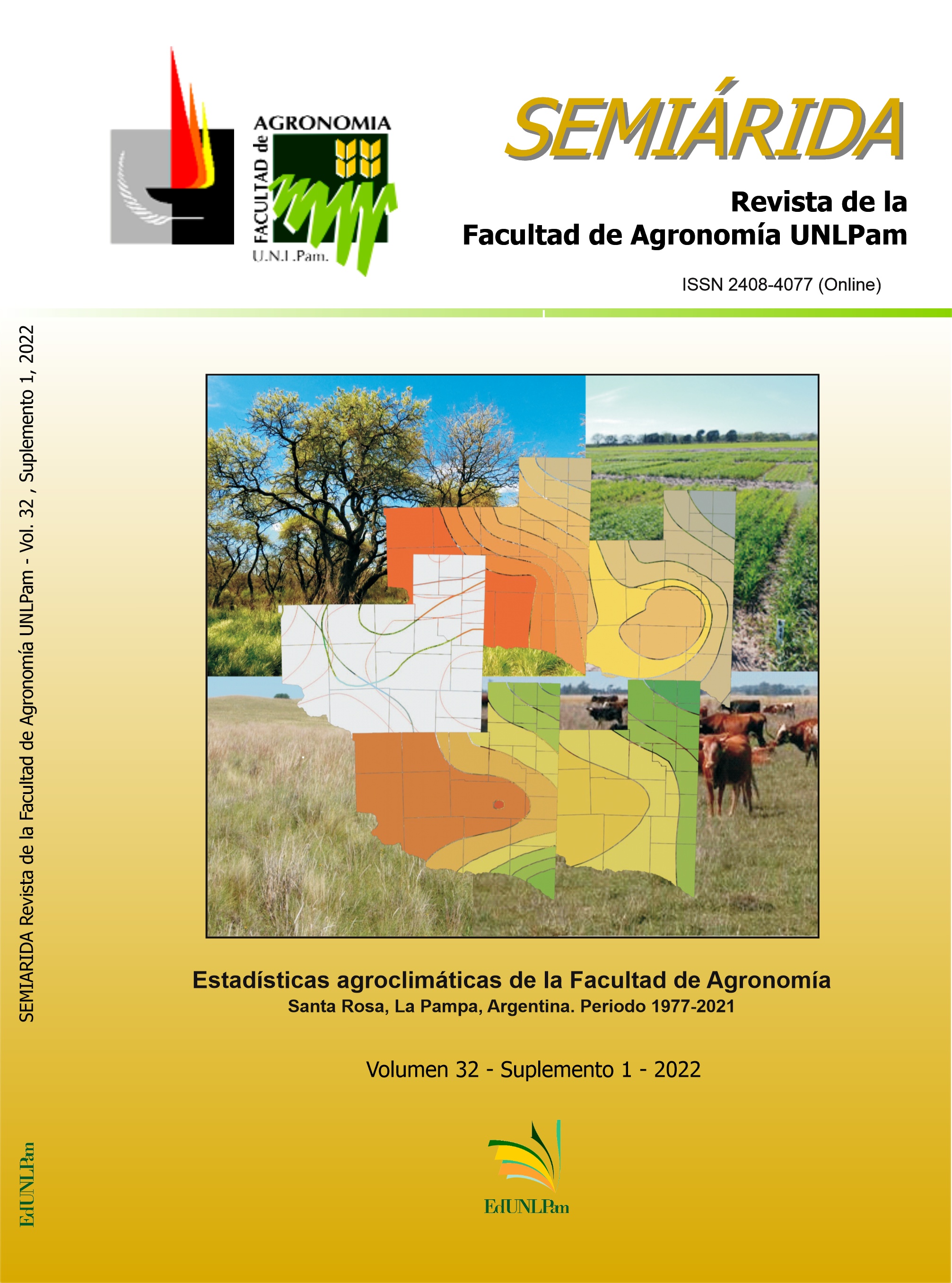SUPLEMENTO 1: Estadísticas agroclimáticas de la Facultad de Agronomía, Santa Rosa, La Pampa, Argentina. Periodo 1977-2021
Keywords:
temperatures, precipitation, Santa Rosa, La Pampa, wind spedd, humidity, evapotranspirationAbstract
Agricultural production requires the management of a set of physical, biological and economic systems. The uncertainty associated with these systems contributes to the complexity of the decision-making process and affects the efficiency of management.
Agrometeorology is a discipline that unites meteorology and agricultural production and attempts to detect and define effects in order to later apply the knowledge obtained. have from the atmosphere to the practical aspects of said production.
The relevance of atmospheric phenomena on agricultural production is evident when we think of catastrophes such as droughts, frosts, hailstorms or floods, but without reaching these extremes, more subtle variations in rainfall, solar radiation, temperature, wind or air humidity, have a considerable impact on the growth and development of plants (crops, weeds), animals and pests in general.
Knowledge of the climate of a place and its variability, from records historical enough long, are essential for the agricultural producer to take the best of decisions, otherwise these would have a very random component. Climate is defined as the average state of the atmosphere and its variations, and it is possible to describe it through the behavior of the elements that compose it. Characterizing the climate of a place is important not only for agricultural planning but also for the correct interpretation of weather forecasts and trends.
One of these tools to characterize the climate is climate statistics, which the authors of this publication make available to researchers, teachers, students, and advisors, so that they can be considered for the development of diagnoses, predictions and strategic designs in modern agronomy.
Downloads
References
Huff, F.A.&Angel, J. R. (1992). Rainfall frequency atlas of the midwest. Midwestern Climate Center and Illinois State Water Survey. Bulletín 71 (MCC Research Report 92 03).
Planchuelo Ravelo, A. M., Seiler, R. A., Pereyra, C., Ravelo, A. C. y Sola, J.bC. (1988). Evapotranspiración y balance hídrico Manual teórico. Asociación Argentina de Agrometeorología. Universidad Nacional de Rio Cuarto.
Ravelo,A. C. (1990). Indices de sequía y de humedad del cultivo Manual teórico operativo. Asociación Argentina de Agrometeorología.
Russelo, D., Edey, S., & Godfrey, J. (1974). Selected tables and conversions used in agrometeorology and related fie1ds. Canada Department of Agriculture, Publication 1522.
Santamaría, J. (1982). Servicio de Computación de Datos. Instituto Nacional de Tecnología Agropecuaria. Castelar. Pcia de Buenos Aires.
Thornthwaite, C. W. (1948).An approach toward a rational classification of climate. Geographical Review, 38, 85-94.
Thornthwaite, C. W., & Mather, J. R. (1955). The Water Balance. Publications in Climatology. Vol. III(1), Laboratory of climatology, Drexel Institute of Technology, Centerton, New Jersey, USA.
Seiler, R., Fabricius, R., Rotondo, V. y Vonocur, M. (1995). Agroclimatología de Río Cuarto - 1974/1993. Volúmen I.Facultad de Agronomía y Veterinaria, Universidad Nacional de Río Cuarto.
Downloads
Published
Issue
Section
License
La Editorial de la Universidad Nacional de La Pampa (EdUNLPam) exigirá a los/as autores/as la firma del siguiente documento:
La EdUNLPam lleva a cabo la publicación del artículo: (Título del Artículo) en SEMIÁRIDA Rev.Fac.Agron UNLPam ISSN 2362-4337 (impresa) ISSN 2408-4077 (en línea), del cual el/los abajo firmantes son autores de una o más partes. En el mismo acto, el/los autores entregan exclusivamente a la EdUNLPam todos sus derechos protegidos por las leyes de propiedad intelectual que rigen en la Argentina para reproducir, publicar, editar, fijar, comunicar y transmitir públicamente en cualquier formato o medio impreso o electrónico, inclusive internet, el artículo enviado a publicación e incluirlo en índices o bases de datos nacionales e internacionales. A cambio, la EdUNLPam entrega a los autores la autorización para la publicación o reimpresión con ines académicos y educativos en cualquier libro o medio de divulgación, con la sola obligación de citar el artículo original publicado en la EdUNLPam. Cada autor acuerda en que el material provisto a la EdUNLPam es un trabajo original, que no ha sido impreso o publicado en cualquier otro medio con anterioridad y que no vulnera derechos de terceros. El Primer autor tendrá la posibilidad de leer y corregir el artículo ya editado como “prueba de galera”, pero si el autor no devolviera esas correcciones de la prueba de galera dentro del tiempo especificado, el proceso de producción y publicación podrá proseguir sin la aprobación del autor. El/los autor/es no recibirán compensación monetaria de la EdUNLPam por el uso del material contenido en este artículo y asumen la responsabilidad de las opiniones vertidas en él.






.png)



22.png)



.jpg)




.jpg)
